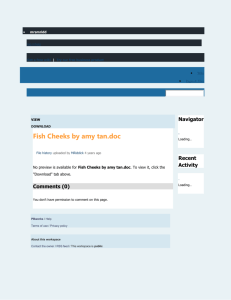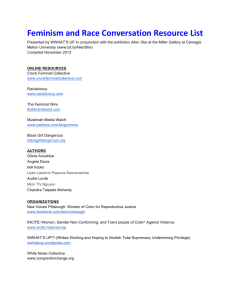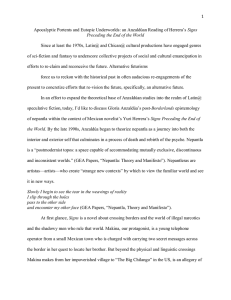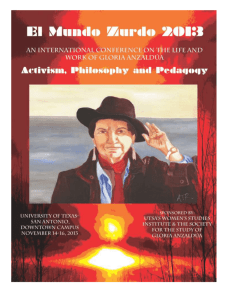File
advertisement
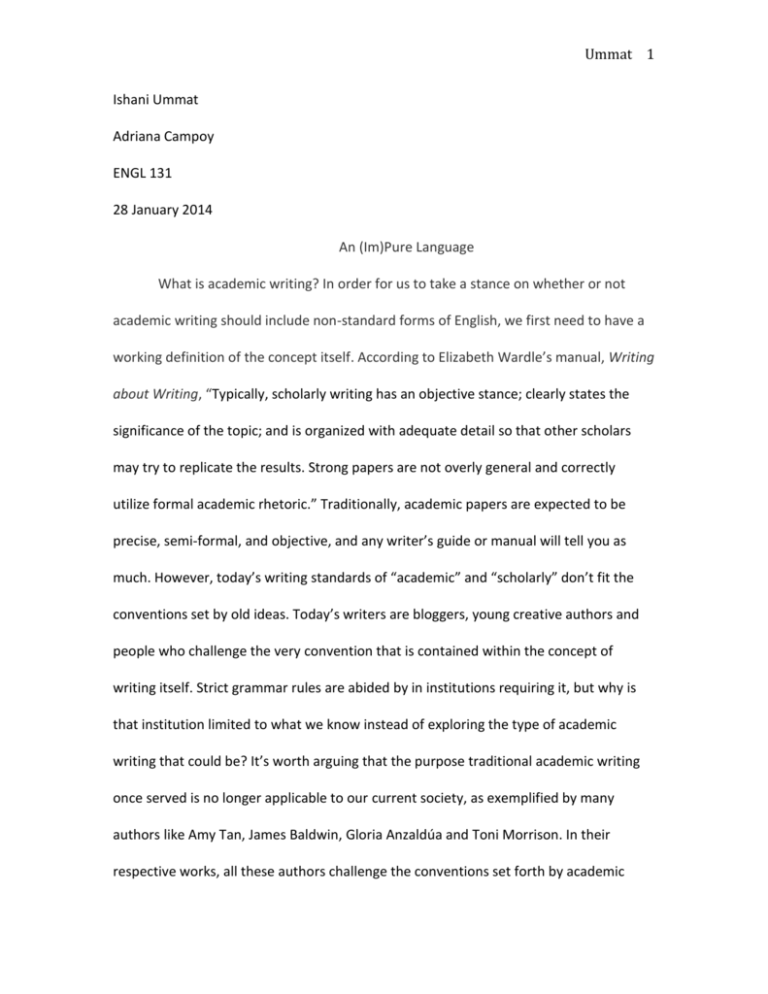
Ummat 1 Ishani Ummat Adriana Campoy ENGL 131 28 January 2014 An (Im)Pure Language What is academic writing? In order for us to take a stance on whether or not academic writing should include non-standard forms of English, we first need to have a working definition of the concept itself. According to Elizabeth Wardle’s manual, Writing about Writing, “Typically, scholarly writing has an objective stance; clearly states the significance of the topic; and is organized with adequate detail so that other scholars may try to replicate the results. Strong papers are not overly general and correctly utilize formal academic rhetoric.” Traditionally, academic papers are expected to be precise, semi-formal, and objective, and any writer’s guide or manual will tell you as much. However, today’s writing standards of “academic” and “scholarly” don’t fit the conventions set by old ideas. Today’s writers are bloggers, young creative authors and people who challenge the very convention that is contained within the concept of writing itself. Strict grammar rules are abided by in institutions requiring it, but why is that institution limited to what we know instead of exploring the type of academic writing that could be? It’s worth arguing that the purpose traditional academic writing once served is no longer applicable to our current society, as exemplified by many authors like Amy Tan, James Baldwin, Gloria Anzaldúa and Toni Morrison. In their respective works, all these authors challenge the conventions set forth by academic Ummat 2 institutions, test limits and explore the many uses of language. They force us to see how these rigid instructions around academic writing reflect the value we still place on convention, and juxtapose it with a modern society that rejects conformity. With the aid of these authors, we can argue that non-traditional English not only should but already is incorporated into academic writing. Toni Morrison, who incorporated “Blacker” English than James Baldwin into her bestselling novel Beloved, served as a celebrated professor of Creative Writing at Princeton University, and what could be established as more academic than that? English has evolved and so have the standards that writers today set for academic writing. There is so much to be said for the mixing cultures and populations represented in English-speaking countries today that isn’t officially reflected in the language books but that is represented in scholarly writing everywhere. Amy Tan’s argument in “Mother Tongue” is sophisticated, complex, states the significance of her topic and is able to hone in on the precise elements that make up her argument. She tells both personal and powerful stories to capture the audience and then makes a very logical and important argument about how non-traditional English is discriminated against in many forms. What part of this is breaking the rules of academic writing? The vernacular we use today, even in typically academic writing, is exceptionally different from the English of two hundred years ago in which Shakespeare reigned. Writing, like language, evolves and so should the standards associated with it, otherwise it is not a good reflection of society’s value and beliefs regarding it. If we take a look at Tan’s argument, she immediately attributes worse SAT, Ummat 3 achievement IQ test scores to her lack of exposure to what we call a conventional English, “While my English skills were never judged as poor, compared to math, English could not be considered my strong suit” (Tan 3). Because her mother’s English was accepted enough at home and in general conversation, but not in an academic setting, Tan was automatically penalized; she became a victim of circumstance, one that almost went into a completely different field because of what “standardized” tests told her. The outside perspective, the one that emphasized a perfect English doesn’t account for what so much of the population experiences as English on a daily basis. Thus, their English’s are neglected and openly discriminated against as “broken” or “limited”. I’m not saying that all the technically incorrect grammatical structures that Tan describes her mother using should be accepted into academic writing but the concept should at least be more widely encompassing, to accurately represent how the people experience English outside of the traditional academic sphere. James Baldwin would happily agree with Amy Tan’s perspective and even go further to suggest that it is less about the language itself and more about the role that it plays. We already accept the different “dialects” or as he refers to them, languages associated with geographical differences, so how come we cannot accept the ones that are seemingly categorized by race? Black Americans have an exceptionally strong communal identity and their English is a huge part of that. He articulates, “Black English is the creation of the black diaspora. Blacks came to the United States chained to each other, but from different tribes: Neither could speak the other's language. If two black people, at that bitter hour of the world's history, had been able to speak to each other, Ummat 4 the institution of chattel slavery could never have lasted as long as it did.” (Baldwin 2). We discriminate, punish for an English that doesn’t fit our constrained definitions of what should be. The implications of this discrimination based on language go far beyond those of academic writing but the concept behind it all remains the same – there is a fundamental problem with how we deal with language and nobody picks it up better than Gloria Anzaldúa. Anzaldúa blends and fuses languages; seamlessly creating a new one that proves her entire point. Her creation is beautiful, it flows mellifluously and we inevitably end up agreeing, siding with her. In a combination of the arguments presented by James Baldwin and Amy Tan, Anzaldúa incorporates personal anecdotes about being discriminated against as a Chiacno, background information about language, culture and her own self. They all come together to form a logical and coherent explanation of why Chicanos are made to feel that their language isn’t a legitimate one, and a call to make our society one of acceptance helps establish one of her most important conclusions: “I am my language” (Anzaldúa 502). The fusion of Spanish and English in her text is designed with specific purposes in mind; it forces those of us who don’t speak Spanish to be inconvenienced, like many Hispanics are with English and it establishes Anzaldúa’s credibility with those who do speak Spanish as a native language. After all, she is one of them. Not only are we appealing to the emotional sense of the reader, but Anzaldúa’s work is literary perfection. It addresses the originality vs. convention paradox by expertly placing the old idea of acceptance that has been tossed around for years, with an entirely new literary approach to it. She creates something original, expanding the Ummat 5 borders of convention in English and at the same time is articulating an argument that intellectuals have made for years about discrimination based on differences in language that need to be broken down. Gloria Anzaldúa epitomizes what should be academic writing because it challenges the limits and pushes the boundaries of the academic writing our society is stuck in. She breaks down the different languages she uses on a daily basis, with whom and explains her reasoning. This is no different than the way you and I alter our language based on whom we are addressing and for what purpose. Anzaldúa even goes into depth about Chicano Spanish itself, detailing how and why it is different from a conventional Spanish we would learn in a classroom setting and the fundamental is that her argument is intellectual, complex, precise and utilizes formal academic rhetoric better than most writers could ever hope to. Her usage of the three Aristotelian appeals rivals that of many famous authors and the addition of Chicano Spanish into her writing gives it even more credibility and influence among a wider audience that matters to her. There are challenges, there are drawbacks and preservation of a language is important, but is it more important than the social progress made by inclusion of languages people speak every day? Many argue that it is simply not practical to include non-standard forms of English in academic writing but the writing itself becomes dry and old-fashioned without incorporating what our global society experiences firsthand as language. Language and academic writing are very different and not to be confused, but there should never be a restriction on what language can be incorporated into academic writing, as long as the level and depth of writing are of the high standard that Ummat 6 academia expects. Yes, to implement this into an academic institution is a serious logistical challenge but at least in my mind, the ideology of inclusiveness and creativity behind it overcomes the practical element. Perhaps this ideology does not transcend discipline. Perhaps there is no way or reason to change the way a scientific research report is written but the humanities have already seen and begun the change towards including non-standard forms of English. James Baldwin, Amy Tan and Gloria Anzaldúa are just a few of the authors that advocate an increase in quality, standard, creativity and effectiveness by including their own languages into academic writing. Ummat 7 Works Cited Anzaldúa, Gloria. "How to Tame Wild Tongue."Borderlands/La Frontera: The New Mestiza. San Francisco: Aunt Lute Books, 1987. 497-506. Print. Baldwin, James. “If Black English Isn’t a Language Then Tell Me, What Is?” Contexts for Inquiry. Boston: Bedford/St. Martin’s, 2008. 507-509 Print. Tan, Amy. “Mother Tongue.” Contexts for Inquiry. Boston: Bedform/St. Martin’s, 2008. 886-890. Print



